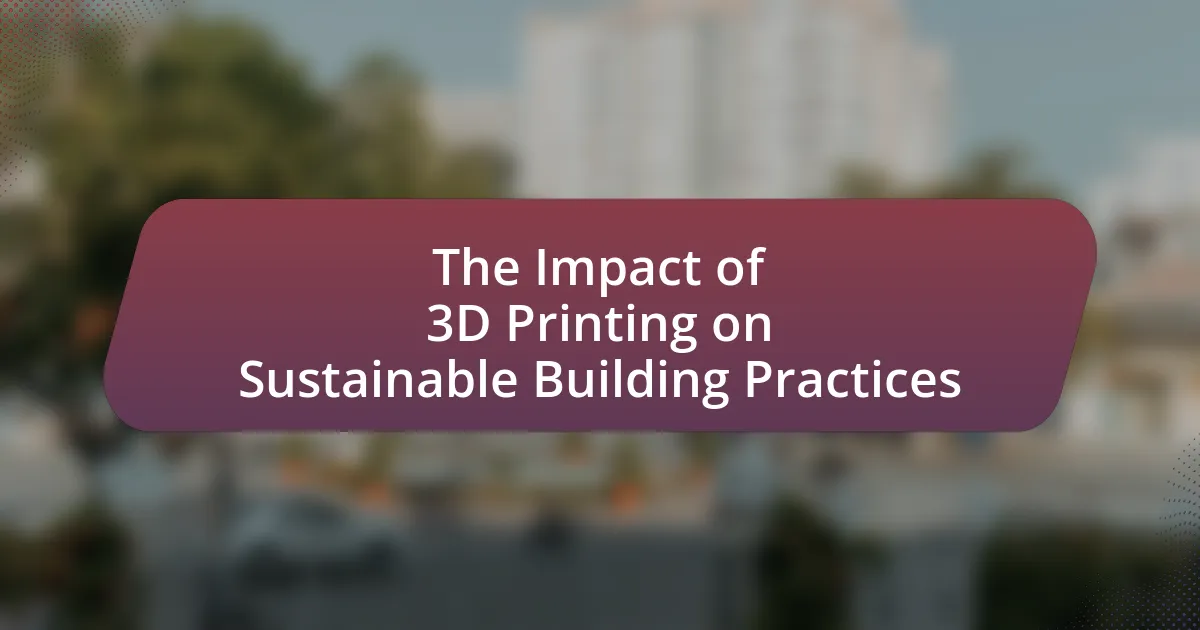Modular construction is a building method that significantly reduces environmental impact through waste minimization and enhanced energy efficiency. By allowing up to 90% of building components to be prefabricated in controlled factory settings, this approach leads to less material waste and lower energy consumption during operation. The article explores the sustainability contributions of modular construction, including the use of sustainable materials, energy-efficient designs, and effective waste management practices. It also addresses the economic benefits associated with reduced waste and faster construction times, while discussing challenges such as transportation emissions and misconceptions that hinder its adoption. Additionally, best practices and technological advancements that can further enhance the environmental benefits of modular construction are examined.

What are the Benefits of Modular Construction in Reducing Environmental Impact?
Modular construction significantly reduces environmental impact by minimizing waste and enhancing energy efficiency. This construction method allows for up to 90% of building components to be prefabricated in a controlled factory environment, which leads to less material waste compared to traditional construction methods. Additionally, modular buildings can be designed for energy efficiency, often incorporating sustainable materials and technologies that reduce energy consumption by up to 30% during operation. Furthermore, the reduced construction time associated with modular techniques decreases the overall carbon footprint, as fewer resources are consumed during the building process.
How does modular construction contribute to sustainability?
Modular construction contributes to sustainability by significantly reducing waste and energy consumption during the building process. This construction method allows for components to be prefabricated in a controlled factory environment, which minimizes material waste by up to 90% compared to traditional construction methods. Additionally, modular buildings can be designed for energy efficiency, often incorporating sustainable materials and technologies that lower operational energy use. Studies indicate that modular construction can reduce the carbon footprint of a building by up to 30% due to these efficiencies and the ability to optimize resource use throughout the construction lifecycle.
What materials are commonly used in modular construction?
Common materials used in modular construction include steel, wood, concrete, and prefabricated panels. Steel is favored for its strength and durability, making it ideal for structural frameworks. Wood is often used for its sustainability and ease of assembly, while concrete provides excellent thermal mass and fire resistance. Prefabricated panels, which can be made from various materials, allow for quick assembly and reduced waste. These materials contribute to the efficiency and environmental benefits of modular construction by minimizing resource use and construction waste.
How do these materials impact the environment?
Modular construction materials significantly reduce environmental impact by minimizing waste and energy consumption. These materials are often prefabricated in controlled factory settings, which leads to more efficient use of resources and less on-site waste compared to traditional construction methods. For instance, studies indicate that modular construction can reduce construction waste by up to 90% and energy use by approximately 20-30% during the building process. Additionally, the use of sustainable materials, such as recycled steel and eco-friendly insulation, further enhances the environmental benefits by lowering carbon emissions associated with material production and transportation.
What are the energy efficiency advantages of modular construction?
Modular construction offers significant energy efficiency advantages, primarily through reduced waste and optimized building processes. The prefabrication of modules in controlled factory settings minimizes material waste by up to 90%, as excess materials can be reused within the production cycle. Additionally, modular buildings are often designed with energy-efficient systems and materials, leading to lower energy consumption during operation. For instance, studies indicate that modular buildings can achieve energy savings of 20-30% compared to traditional construction methods due to better insulation and energy-efficient appliances. This combination of reduced waste and enhanced energy performance contributes to a lower overall environmental impact.
How does modular construction minimize energy consumption during building?
Modular construction minimizes energy consumption during building by utilizing prefabricated components that are manufactured in controlled environments, which reduces waste and energy use. This method allows for precise engineering and efficient use of materials, leading to a significant decrease in energy required for construction processes. Studies indicate that modular construction can reduce energy consumption by up to 67% compared to traditional building methods, as it streamlines logistics and minimizes on-site construction time, which further lowers energy expenditure.
What role does insulation play in energy efficiency?
Insulation significantly enhances energy efficiency by reducing heat transfer between the interior and exterior of a building. This reduction in heat transfer minimizes the need for heating and cooling systems to operate, leading to lower energy consumption. According to the U.S. Department of Energy, proper insulation can reduce energy bills by 20% to 30%. By maintaining a stable indoor temperature, insulation not only conserves energy but also contributes to a more comfortable living environment.
How does modular construction reduce waste?
Modular construction reduces waste by utilizing prefabricated components that are manufactured in controlled factory settings, which minimizes material excess and on-site waste. This method allows for precise measurements and efficient use of materials, leading to a reduction in the overall waste generated during the construction process. According to a study by the National Institute of Standards and Technology, modular construction can reduce construction waste by up to 90% compared to traditional building methods, demonstrating its effectiveness in minimizing environmental impact.
What are the waste management practices in modular construction?
Waste management practices in modular construction include efficient material utilization, recycling, and waste reduction strategies. Modular construction minimizes on-site waste by prefabricating components in a controlled factory environment, which allows for precise measurements and reduces excess material. According to a study by the National Institute of Standards and Technology, modular construction can reduce construction waste by up to 90% compared to traditional methods. Additionally, materials that are not used can often be recycled or repurposed, further decreasing landfill contributions. These practices not only enhance sustainability but also contribute to cost savings and improved project timelines.
How does off-site construction help in waste reduction?
Off-site construction significantly aids in waste reduction by allowing for precise manufacturing processes in controlled environments. This method minimizes material waste through optimized cutting and assembly techniques, as components are prefabricated to exact specifications before arriving at the construction site. According to a study by the National Institute of Standards and Technology, off-site construction can reduce waste by up to 20% compared to traditional on-site methods, as it limits the excess materials generated during construction activities. Additionally, the use of standardized components further enhances efficiency, leading to less scrap and more sustainable resource utilization.

What are the Economic Benefits of Modular Construction Related to Environmental Impact?
Modular construction offers significant economic benefits related to environmental impact by reducing waste and energy consumption during the building process. This construction method typically generates 60% less waste compared to traditional construction, as components are prefabricated in a controlled factory setting, allowing for precise material usage. Additionally, modular buildings can be completed 30-50% faster, leading to lower labor costs and reduced financing expenses. The efficiency of modular construction also translates to lower energy consumption during the building phase, which can result in long-term savings on utility costs for occupants. Furthermore, studies indicate that modular buildings can achieve higher energy efficiency ratings, contributing to lower operational costs over time.
How does modular construction lower overall project costs?
Modular construction lowers overall project costs by significantly reducing labor expenses and construction time. The off-site manufacturing process allows for simultaneous site preparation and module construction, which can cut project timelines by up to 50%. This efficiency leads to lower labor costs, as fewer workers are needed on-site for a shorter duration. Additionally, the controlled factory environment minimizes material waste, with studies indicating that modular construction can reduce waste by 20% to 30% compared to traditional methods. These factors combined result in a more cost-effective approach to building projects.
What are the cost savings associated with reduced material waste?
Reduced material waste in construction leads to significant cost savings, primarily by lowering material procurement expenses and minimizing disposal costs. For instance, studies indicate that modular construction can reduce waste by up to 90%, translating to savings of approximately 20% on overall project costs. This reduction occurs because less material is purchased, and the need for landfill disposal is decreased, which can incur additional fees. Furthermore, efficient use of materials enhances project timelines, leading to reduced labor costs and increased productivity.
How does faster construction time contribute to economic benefits?
Faster construction time contributes to economic benefits by reducing labor costs and accelerating project delivery, which leads to quicker returns on investment. For instance, projects completed in a shorter timeframe can generate revenue sooner, enhancing cash flow for developers and investors. Additionally, reduced construction duration minimizes overhead expenses, such as site management and equipment rental, further lowering overall project costs. According to a study by McKinsey & Company, construction projects that utilize modular techniques can be completed up to 50% faster than traditional methods, demonstrating a clear link between speed and economic efficiency.
What incentives exist for using modular construction in sustainable projects?
Incentives for using modular construction in sustainable projects include reduced construction waste, shorter project timelines, and improved energy efficiency. Modular construction typically generates 30-50% less waste compared to traditional building methods, as components are prefabricated in controlled environments, allowing for precise material usage. Additionally, projects can be completed 20-50% faster due to simultaneous site preparation and module construction, leading to quicker occupancy and reduced environmental disruption. Energy efficiency is enhanced through better insulation and airtightness in modular units, which can result in lower operational energy costs and a smaller carbon footprint over the building’s lifecycle.
How do government policies support modular construction?
Government policies support modular construction by providing financial incentives, regulatory frameworks, and streamlined permitting processes that encourage the adoption of this building method. For instance, various governments offer tax credits and grants to developers who utilize modular techniques, which can significantly reduce construction costs and promote sustainable practices. Additionally, policies that prioritize energy efficiency and sustainability in building codes often favor modular construction due to its inherent efficiency and reduced waste. According to a report by the Modular Building Institute, modular construction can reduce waste by up to 90% compared to traditional methods, aligning with government goals for environmental sustainability.
What financial benefits do companies gain from sustainable practices?
Companies gain significant financial benefits from sustainable practices, including cost savings, increased efficiency, and enhanced brand reputation. By implementing sustainable practices, companies can reduce operational costs through energy efficiency and waste reduction, leading to lower utility bills and disposal fees. For instance, a study by McKinsey found that companies adopting sustainable practices can achieve cost reductions of up to 20% in their supply chains. Additionally, sustainable practices can improve operational efficiency, as seen in modular construction, which often results in faster project completion times and reduced labor costs. Furthermore, companies that prioritize sustainability tend to attract more customers and investors, as consumers increasingly prefer brands that demonstrate environmental responsibility. This shift can lead to increased sales and market share, reinforcing the financial advantages of sustainable practices.

What Challenges Does Modular Construction Face in Environmental Sustainability?
Modular construction faces significant challenges in environmental sustainability, primarily due to material waste, energy consumption, and transportation emissions. The prefabrication process can lead to excess materials that are not utilized, contributing to landfill waste. Additionally, while modular buildings can be energy-efficient, the manufacturing phase often requires substantial energy input, which can negate some sustainability benefits. Transportation of modular units to construction sites also generates greenhouse gas emissions, particularly if the units are shipped over long distances. These factors collectively hinder the overall environmental sustainability of modular construction despite its potential advantages in reducing waste and improving efficiency.
What are the common misconceptions about modular construction?
Common misconceptions about modular construction include the belief that it is of lower quality than traditional building methods, that it is only suitable for temporary structures, and that it lacks design flexibility. Research indicates that modular buildings can meet or exceed the quality standards of conventional construction, as they are built in controlled factory environments, which reduces defects and enhances durability. Additionally, modular construction is not limited to temporary structures; it is increasingly used for permanent buildings, including residential homes and commercial spaces. Furthermore, modular construction allows for significant design customization, enabling architects to create unique and aesthetically pleasing structures while still benefiting from the efficiency of the modular process.
How do these misconceptions affect its adoption?
Misconceptions about modular construction significantly hinder its adoption by creating skepticism regarding its quality and sustainability. For instance, many believe that modular buildings are inferior in quality compared to traditional construction, which is inaccurate; studies show that modular construction can achieve higher quality standards due to controlled factory conditions. Additionally, misconceptions about the environmental impact of modular construction, such as the belief that it is less eco-friendly, are unfounded; research indicates that modular construction can reduce waste by up to 90% and lower carbon emissions during the building process. These misconceptions lead to resistance from stakeholders, limiting the widespread acceptance and implementation of modular construction practices that could otherwise contribute to reducing environmental impact.
What evidence counters these misconceptions?
Evidence counters misconceptions about modular construction’s environmental impact by demonstrating its efficiency and sustainability. Studies show that modular construction can reduce waste by up to 90% compared to traditional building methods, as prefabrication allows for precise material usage and minimizes excess. Additionally, research from the National Institute of Standards and Technology indicates that modular buildings can achieve energy savings of 20-30% during their lifecycle due to improved insulation and energy-efficient designs. These findings highlight that modular construction not only meets but often exceeds traditional methods in terms of environmental benefits.
What are the limitations of modular construction in reducing environmental impact?
Modular construction has limitations in reducing environmental impact primarily due to transportation emissions and material waste. The process often requires transporting large modules over significant distances, which contributes to greenhouse gas emissions. Additionally, while modular construction aims to minimize waste, the reality is that off-site manufacturing can still generate excess materials that may not be recyclable. A study by the National Institute of Standards and Technology found that transportation can account for up to 30% of the total carbon footprint of modular buildings, highlighting the environmental cost associated with logistics. Furthermore, the reliance on specific materials, such as steel and concrete, can negate some of the sustainability benefits if those materials are not sourced responsibly.
How do transportation and logistics affect sustainability?
Transportation and logistics significantly impact sustainability by influencing carbon emissions, resource consumption, and waste generation. Efficient transportation systems reduce fuel consumption and greenhouse gas emissions, while optimized logistics minimize resource use and enhance supply chain efficiency. For instance, the Global Logistics Emissions Council reported that logistics operations account for approximately 7% of global CO2 emissions, highlighting the need for sustainable practices. Implementing strategies such as route optimization and modal shifts to greener transport options can further decrease environmental footprints, demonstrating the critical role of transportation and logistics in promoting sustainability.
What challenges exist in sourcing sustainable materials?
Sourcing sustainable materials faces several challenges, including limited availability, higher costs, and inconsistent quality. Limited availability arises because sustainable materials often come from specific regions or require particular growing conditions, making them less accessible than conventional materials. Higher costs are associated with the production and certification processes of sustainable materials, which can deter manufacturers from using them. Inconsistent quality can occur due to variations in sourcing practices and supply chain transparency, leading to difficulties in meeting industry standards. These challenges hinder the widespread adoption of sustainable materials in construction and manufacturing sectors.
What best practices can enhance the environmental benefits of modular construction?
Implementing best practices such as using sustainable materials, optimizing design for energy efficiency, and minimizing waste can significantly enhance the environmental benefits of modular construction. Sustainable materials, like recycled steel and certified wood, reduce resource depletion and lower carbon footprints. Optimizing design for energy efficiency, through strategies like passive solar design and high-performance insulation, can lead to reduced energy consumption during the building’s lifecycle. Additionally, minimizing waste through precise manufacturing processes and recycling excess materials can decrease landfill contributions. According to a study by the National Institute of Standards and Technology, modular construction can reduce construction waste by up to 90%, demonstrating the effectiveness of these practices in promoting sustainability.
How can companies implement sustainable sourcing strategies?
Companies can implement sustainable sourcing strategies by prioritizing suppliers that adhere to environmentally friendly practices and ethical labor standards. This involves conducting thorough assessments of potential suppliers to ensure they utilize sustainable materials, minimize waste, and reduce carbon emissions. For instance, a study by the World Economic Forum highlights that companies adopting sustainable sourcing can reduce their supply chain emissions by up to 30%. Additionally, establishing long-term partnerships with suppliers who demonstrate a commitment to sustainability fosters innovation and continuous improvement in sourcing practices.
What role does technology play in improving modular construction practices?
Technology significantly enhances modular construction practices by streamlining design, manufacturing, and assembly processes. Advanced software tools, such as Building Information Modeling (BIM), enable precise planning and visualization, reducing errors and waste during construction. Additionally, automation in manufacturing facilities increases production efficiency and consistency, leading to higher quality modules. For instance, a study by the National Institute of Standards and Technology found that using BIM can reduce project delivery times by up to 30%. Furthermore, technologies like 3D printing and robotics facilitate the creation of complex designs while minimizing material usage, contributing to sustainability goals. Overall, technology plays a crucial role in optimizing modular construction, ultimately reducing its environmental impact.





